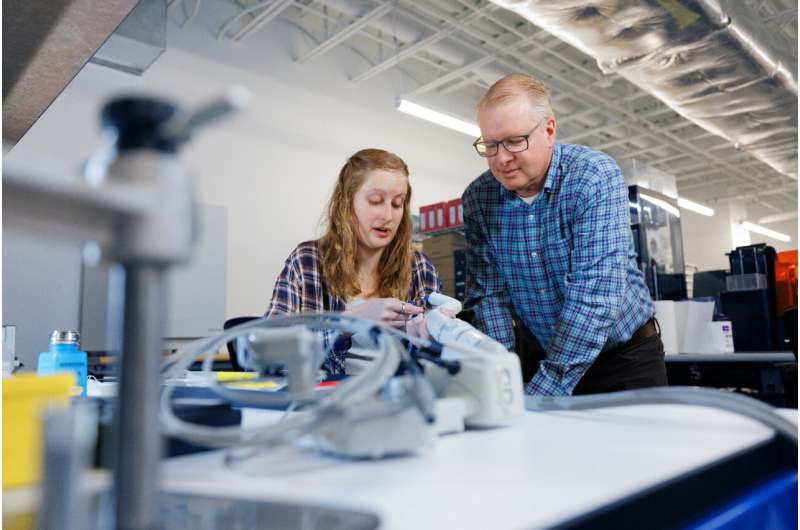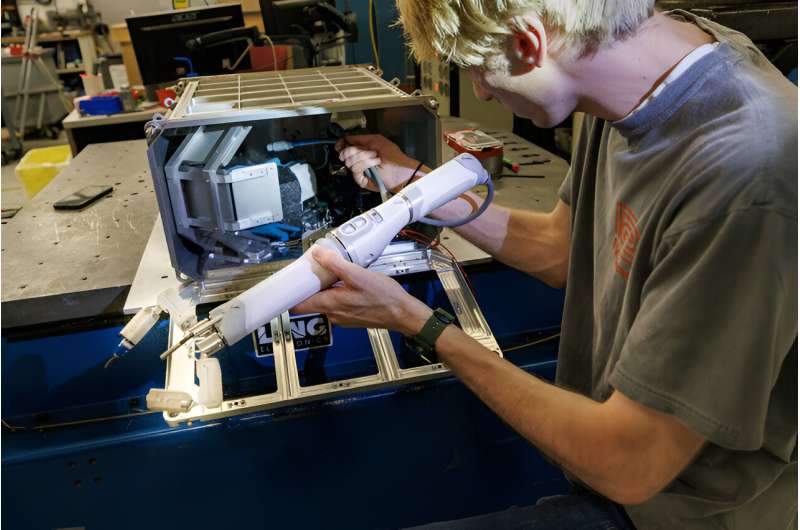This article has been reviewed according to Science X's editorial process and policies. Editors have highlighted the following attributes while ensuring the content's credibility:
fact-checked
trusted source
proofread
Surgical robot developed at Nebraska launches into space

A surgeon's hands could stretch 250 miles above Earth, should an upcoming test of a miniaturized surgical robot aboard the International Space Station prove successful.
Invented by University of Nebraska-Lincoln's Shane Farritor and others, the robot blasted off Jan. 30 from Florida's Cape Canaveral Space Force Station aboard a Northrup Grumman Cygnus spacecraft bound for the orbital laboratory. The Cygnus was carried by a SpaceX Falcon 9 rocket.
It will be the first surgical robot on the space station and one of the first times remote surgery tasks have been tested in space.
The mission will help identify the next steps for creating surgical technologies suitable for long-distance space travel, but it also has implications for health care here on Earth.
"While space travel is exciting to think about, there is also an immediate need on Earth to help patients get the care they need," said Farritor, Lederer Professor of Engineering at the University of Nebraska-Lincoln and chief technology officer for Virtual Incision, a startup company he co-founded to bring the miniature robot to the commercial market.
According to a 2018 report published by the American College of Surgeons, about one-third of U.S. counties lack a surgeon, despite half of those counties being home to a hospital. Research from the University of Washington showed that availability of surgeons in rural areas declined by more than 29% between 2001 and 2019.
"Remote surgery has the potential to address these issues so patients can get the health care they need," Farritor said.
Farritor and his team have been preparing a space-worthy version of their robot, named MIRA, for Miniaturized In vivo Robotic Assistant, for about two years.

The vision for MIRA is to perform surgery in remote areas, whether space, military battlefields or rural areas where no doctor is at hand.
In an experiment to take place in coming weeks, a Lincoln surgeon who has assisted with previous tests of the device will guide spaceMIRA as it uses both "hands" to perform a surgical simulation. The tasks mimic surgical tissue with tension that allows a dissection to be performed. Riding inside an experiment locker the size of a microwave oven, spaceMIRA will use its left arm to grasp, and its right arm to cut, much like a human surgeon in a hospital operating room.
"The two-handed approach is critical in surgical procedures because local tension is key to determining the ideal locations to resect and to cut in the desired way," Farritor explained.
Doctoral student Rachael Wagner of Lincoln and master's student Victoria Nelson of Sioux City, Iowa, spent a week at the Marshall Space Flight Center in Huntsville, Alabama, working with NASA engineers to evaluate the robot before it joined the payload for delivery to the International Space Station.
"There is a bunch of testing required for NASA to make sure the payload is safe and meets all their requirements," said Wagner, who serves as engineering lead for the project. "There are also tests to assure ourselves the hardware is up to snuff—that it can survive the launch and work on orbit."
Originally, spaceMIRA was to be pre-programmed to perform surgery-like tasks without human involvement for this experiment. The ground-control element adds an extra layer of difficulty to MIRA's mission. Latency—the delay that occurs while awaiting a signal to travel from the Earth to the International Space Station and back—is one of the biggest. Even a half-second delay could cause problems.
"There's lots of obstacles," Farritor said. "As we've learned recently, it can be hard to get the Zoom conference room to work right—let alone this."
Farritor and his colleagues began developing MIRA nearly 20 years ago. The team will receive data about the robot's performance during the space station tests before MIRA returns to Earth in its locker later this spring. It likely will be a year or more before test results are published.
"It's taken a lot of testing to build up to this, and we're still a long way from telesurgery on an actual patient," Farritor said. "The first step is to demonstrate the technology."


















